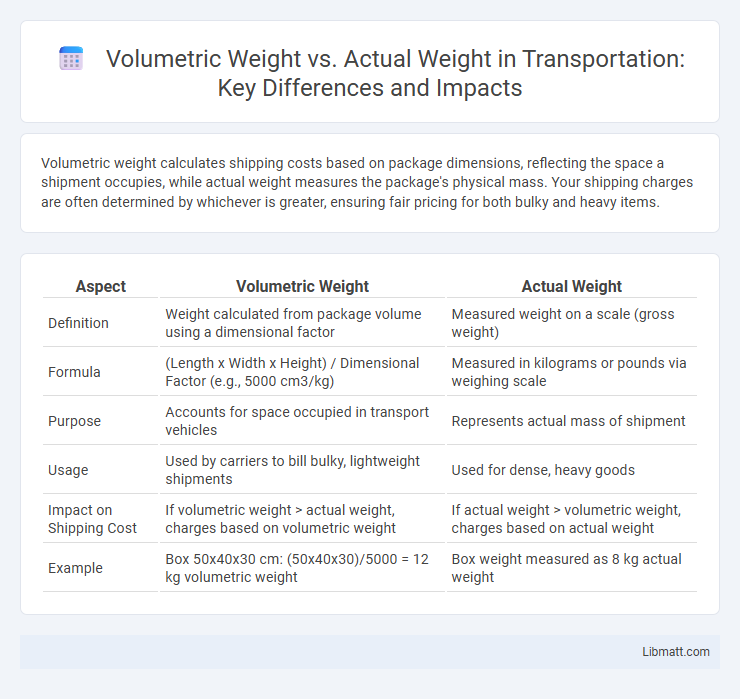Volumetric weight calculates shipping costs based on package dimensions, reflecting the space a shipment occupies, while actual weight measures the package's physical mass. Your shipping charges are often determined by whichever is greater, ensuring fair pricing for both bulky and heavy items.
Table of Comparison
| Aspect | Volumetric Weight | Actual Weight |
|---|---|---|
| Definition | Weight calculated from package volume using a dimensional factor | Measured weight on a scale (gross weight) |
| Formula | (Length x Width x Height) / Dimensional Factor (e.g., 5000 cm3/kg) | Measured in kilograms or pounds via weighing scale |
| Purpose | Accounts for space occupied in transport vehicles | Represents actual mass of shipment |
| Usage | Used by carriers to bill bulky, lightweight shipments | Used for dense, heavy goods |
| Impact on Shipping Cost | If volumetric weight > actual weight, charges based on volumetric weight | If actual weight > volumetric weight, charges based on actual weight |
| Example | Box 50x40x30 cm: (50x40x30)/5000 = 12 kg volumetric weight | Box weight measured as 8 kg actual weight |
Understanding Volumetric Weight
Volumetric weight measures the amount of space a package occupies in relation to its actual weight, calculated using length, width, and height dimensions. Shipping carriers often use the higher value between volumetric weight and actual weight to determine charges, impacting your shipping costs significantly. Understanding volumetric weight helps you optimize packaging and avoid unexpected fees.
What Is Actual Weight?
Actual weight refers to the physical weight of a package, measured using a scale and expressed in pounds or kilograms. It represents the true mass of your shipment without considering its dimensions or volume. Understanding actual weight is crucial for calculating shipping costs, especially when it is heavier than the volumetric weight.
Key Differences Between Volumetric and Actual Weight
Volumetric weight measures the space a package occupies, calculated using length, width, and height, while actual weight refers to the physical weight measured on a scale. Shipping carriers use volumetric weight to determine shipping costs when a package's size exceeds its actual weight, impacting your freight charges. Understanding these key differences helps optimize packaging and reduce unexpected shipping expenses.
Why Volumetric Weight Matters in Shipping
Volumetric weight matters in shipping because it determines shipping costs based on the package's size rather than just its actual weight, ensuring carriers efficiently use cargo space. This measurement helps prevent undercharging for large, lightweight items that occupy significant volume in transport vehicles. Understanding volumetric weight enables businesses to optimize packaging and reduce unexpected shipping expenses.
How to Calculate Volumetric Weight
Volumetric weight is calculated by measuring the package's length, width, and height in centimeters, multiplying these dimensions, and then dividing the result by a dimensional factor, typically 5000 for air freight shipments. This calculation estimates the space a package occupies compared to its actual weight in kilograms, helping carriers determine shipping costs more accurately. Understanding volumetric weight ensures correct pricing when the package's volume exceeds its actual weight.
Common Industries Affected by Weight Measurements
E-commerce, logistics, and air freight industries heavily rely on accurate comparisons between volumetric weight and actual weight to determine shipping costs and space utilization. Freight companies use volumetric weight calculations to optimize cargo loads and reduce transportation expenses, especially for lightweight but bulky packages. Retail and manufacturing sectors also monitor these weight measurements to enhance inventory management and align pricing strategies with shipping expenditures.
Shipping Cost Implications: Volumetric vs Actual Weight
Shipping cost implications hinge on whether the volumetric weight or actual weight of a package is higher, as carriers charge based on the greater value. Volumetric weight calculates the space a package occupies using dimensional measurements, often resulting in higher fees for large, lightweight items compared to actual weight. Understanding this distinction helps you optimize packaging and reduce shipping expenses effectively.
Tips to Minimize Shipping Charges
To minimize shipping charges, accurately calculate both volumetric weight and actual weight, as carriers charge based on whichever is higher. Use compact packaging to reduce dimensional weight and avoid unnecessary space, helping lower volumetric weight costs. You can also compare carrier rate structures and choose services optimized for your shipment's size and weight to save on fees.
Choosing the Right Packaging for Optimal Weight
Choosing the right packaging directly impacts whether volumetric weight or actual weight governs your shipping costs, as carriers charge based on the higher value. Understanding the dimensional weight formula helps you select packaging that minimizes unused space, thereby reducing volumetric weight and overall shipping expenses. By optimizing your package size, you ensure your shipment weights reflect your actual contents, saving you money and improving efficiency.
Frequently Asked Questions About Volumetric and Actual Weight
Volumetric weight and actual weight are key factors in shipping cost calculations, with volumetric weight based on package dimensions and actual weight measured by scale. You should compare both weights as carriers charge based on the higher value to account for bulky, lightweight items. Common questions include how to calculate volumetric weight, when dimensional weight pricing applies, and why discrepancies between actual and volumetric weight impact your shipping fees.
volumetric weight vs actual weight Infographic

 libmatt.com
libmatt.com